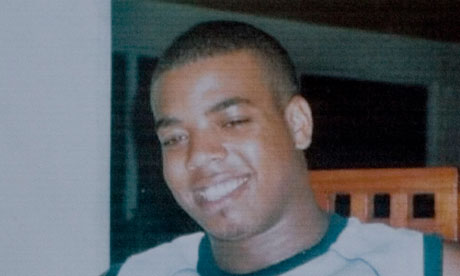A man suspected of being part of a plot to rip off a Colombian drug gang at gunpoint was killed by an armed police officer who shot him six times in seconds without issuing an oral warning, an inquiry has heard.
The officer known only as E7 opened fire less than one second after pulling alongside a car carrying Azelle Rodney, 24, who was in a rear seat.
A public inquiry chaired by a former high court judge, Sir Christopher Holland, began on Monday into the shooting which took place on 20 April 2005 in Mill Hill, north London.
Rodney's family have fought a seven-year battle for a public and full inquiry into his death. The authorities had previously said this would not be possible because the intelligence used by law enforcement came from intercepts, whose disclosure to lawyers and the family was claimed to be unlawful.
The police operation followed intelligence from Customs and Excise that a gang would stage an armed heist against Colombian drug pushers on the streets of London, and steal their class A drugs.
The sensitive intelligence in this case, was one of the reasons that the last Labour government and then the current Conservative-led coalition considered introducing so called "secret inquests".
The intelligence in the Rodney case was passed to the Metropolitan police, which decided against arresting the men before they were in possession of firearms because they would not have sufficient evidence to prosecute them. Internal police documents made public on Monday show senior officers believed they needed to confront the gang once they were in possession of weapons to best reduce the danger to the public and to officers.
The case raises several issues about police use of deadly force, including whether police can open fire without seeing a suspect threatening them with a weapon, and the role of intelligence in a firearms officer's mind when assessing the level of threat posed by a suspect.
An investigation by the Independent Police Complaints Commission exonerated the police, and the Crown Prosecution Service decided there was no criminal case for police to answer.
Opening the inquiry, Ashley Underwood QC, said officer E7 pulled alongside side Rodney as part of a hard stop by police, forcing the Volkswagen Golf he was travelling to halt as officers in three cars boxed the suspect's vehicle in.
Underwood said: "Within less than a second of the car containing the officer coming to a halt, he opened fire with a carbine. He fired eight shots rapidly. Of these, six shots hit Mr Rodney. He was killed more or less instantly."
Underwood said weapons were recovered from the silver Golf. One could not fire and was located under some yellow plastic on the rear seat. A pistol was recovered from the vehicle's rear footwell, wrapped inside a scarf inside a rucksack containing four rounds, and thirdly, in the same rucksack was a gun that looked like a key fob which contained two rounds of ammunition.
Internal police documents about the operation say it was possible the gang that police believed Rodney was part of might have been armed with a machine gun.
Tests carried out for the inquiry show that E7 had sight of Rodney for 0.88 seconds before starting to fire.
Two men in the car were later convicted for firearms offences.
Rodney's mother, Susan Alexander, was in court to hear the evidence, with family members leaving briefly when gruesome photographs of the aftermath of the shooting were shown.
The dead man's family fought plans for an inquest into the death to be held, in which secret evidence would be withheld from them and their lawyers.
Underwood praised Ms Alexander's "dignity" and her "reasonable and positive approach" which helped the inquiry navigate complex legal obstacles to get started.
Underwood also praised the Met for their assistance and help in providing documents to explain the planning of the operation and its tactics.
Firearms officers will testify in coming weeks, as will intelligence officers. Their evidence will be open to the public but their identities will be protected.
The inquiry heard that one option considered was arresting those suspected of planning the heist for lesser offences. Rodney was a suspect in an earlier serious assault but this was not known to officers trying to stop what they considered was an imminent armed robbery.
The inquiry continues, and is expected to last 10 weeks.
